What distinguishes fashion and comfortable kitchen XXI century? Stylish furniture, right organized space, modern technology and, of course, high-quality kitchen utensils. And one of the main components of the “hostess tool kit”, without which we cannot do, despite all Food processors, blenders and meat grinders are carving knives. In the modern kitchen industry, knives, as well as places for their convenient and safe storage, are of great importance. As well as the question of how to sharpen kitchen knives correctly and quickly: an entire industry is working on the production of sharpeners, from simple disc sharpeners to high-tech electric ones.
The knife is a very ancient object, the shape and purpose of which in in general terms have not changed for thousands of years. It still consists of a sharp blade (the shape of the cutting part depends on the purpose of the tool) and a comfortable handle, the only difference is in the material and finish. We inherited not only the shape of the knife, but the echoes of the beliefs of our ancestors associated with it. After all, among the ancient Russians, he was not only an important item in the household, but also protected from evil spirits; participated in oaths and conspiracies. And given to a child, it symbolized the transition to adulthood, from a boy to a man. The father showed his son how to straighten a knife, how to make a sheath for it and how to handle it.
Now knives, although they "dissolve" in the kitchen setting, are still in a special account. They are collected; they are made important detail decorating the kitchen, buying unusual coasters and holders. Agree, no ladles and spatulas receive such attention! And it is a matter of honor for any owner to sharpen kitchen knives correctly. Partly because of the stereotype that, like the tool itself, came to us from the distant past: "Sharp knives in the kitchen - a good master in the house." But mainly due to the fact that with well-sharpened knives, cooking becomes a pleasure. And the preparation and serving of some dishes (salads, rolls, cold cuts) simply require the maximum sharpness of the working tool!
Why do knives get dull?
A knife loses its sharpness when its blade comes into contact with something hard. If you frequently cut meat that has bones in it, the blade will need to be sharpened almost daily.
Knives quickly become dull, the owners of which cut food on stone countertops without a cutting board. In order not to correct it daily, make it a rule to always use the board. The most "friendly" for the blade is wooden plank. Plastic, glass, ceramic boards are undesirable because they also dull the blades.
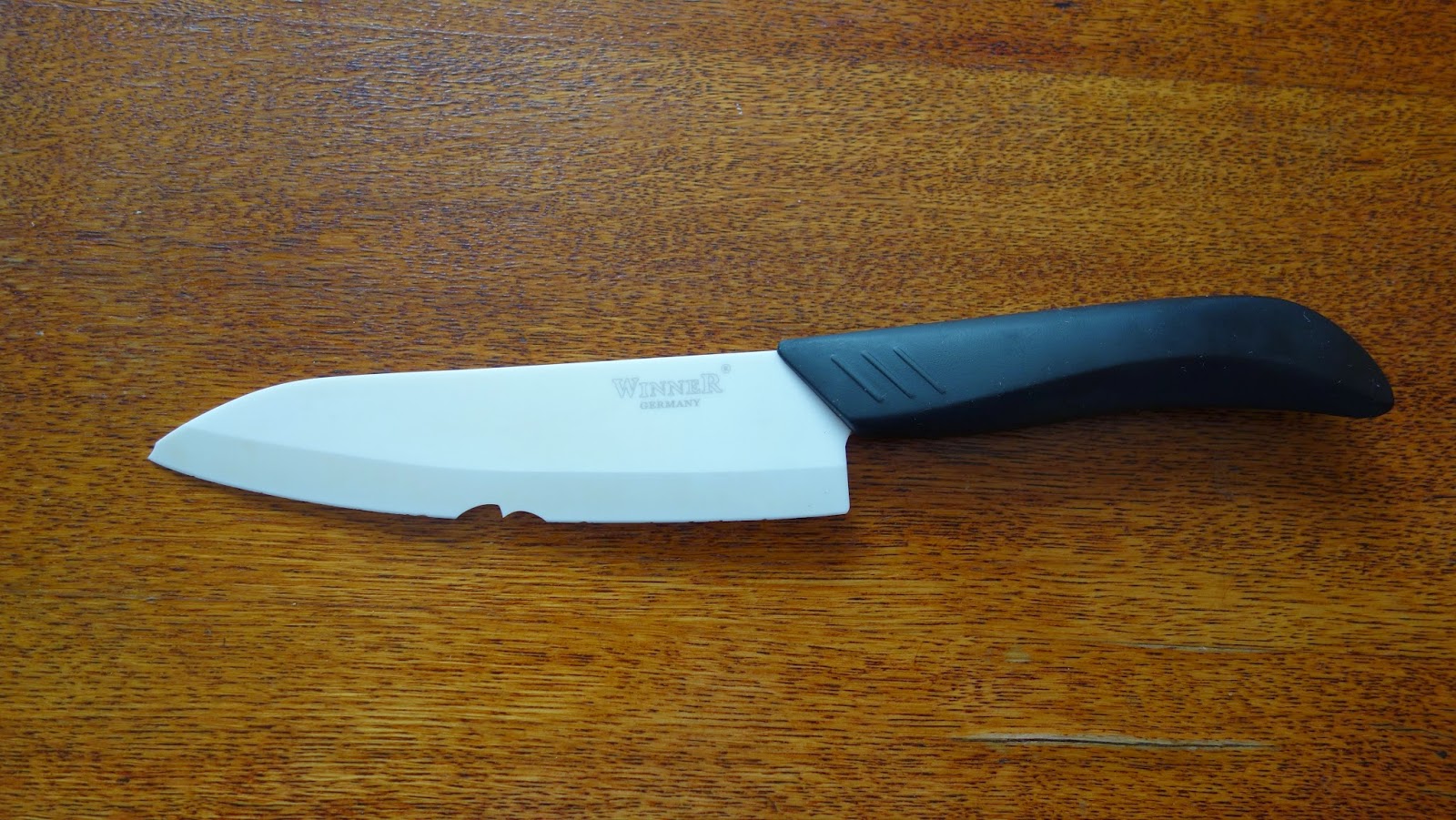
An experienced housewife will always understand when it is time to sharpen a kitchen tool: when cutting any food, from meat to vegetables, a dull blade makes itself felt. Despite all the stereotypes that knife sharpening is a male occupation, anyone who reads this article and follows our advice will be able to cope with this business.
A sharp blade is easy!
The "machine age" weaned us from self made. Now all things can be bought ready-made or ordered in special workshops. But sharpening knives is one of those skills that are worth learning. Firstly, it will help you always keep all the cutting tools in your kitchen in perfect condition, without wasting time and money on turning to master grinders. And secondly, this skill will definitely give you a special charm in the eyes of your surroundings!
We will share tips and experience on how to properly sharpen kitchen knives using a variety of tools, from a grinder to ... an ordinary ceramic mug. Having reinforced our advice with practice, you will quickly master knife sharpening and will be able to easily understand all possible devices for this.
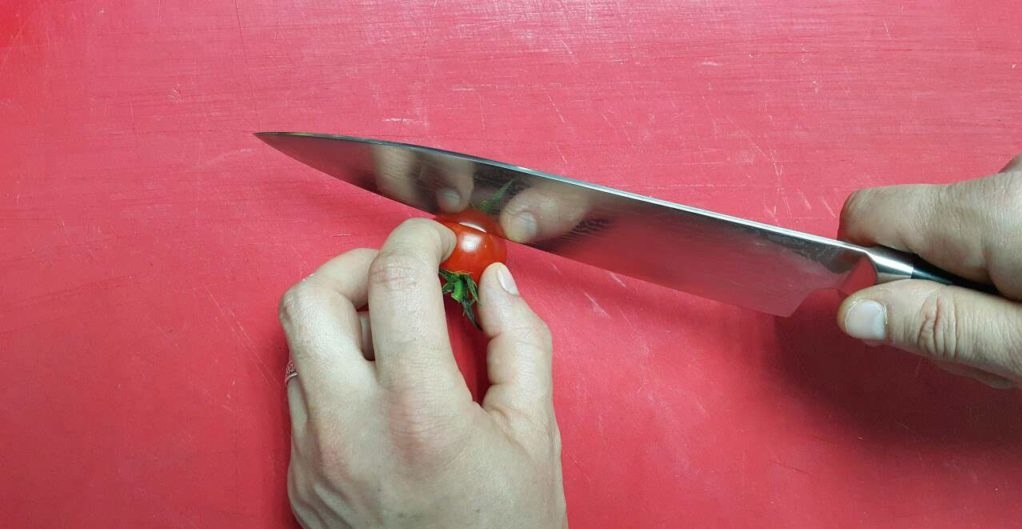
Please note: the methods we offer are only suitable for steel knives with a straight blade. There are several categories of knives that self-cutting and sharpening can only damage:
- Ceramic;
- With a "teeth" or "wave" blade
- "Magnetic".
Trying to restore sharpness to any of these types of blades yourself, you only risk breaking or ruining it. So, Ceramic knives can only be sharpened in a specialized workshop, on a machine tool, using diamond paste; or specialized sharpeners or diamond-coated discs. Sharpening a kitchen tool with a wavy blade also requires a special device, which is simply unprofitable to buy for home use. Well, a blade with a magnetic layer cannot be sharpened without damaging this layer. Therefore, our advice: if you decide to purchase knives of any of these three types, choose a quality item. famous brand. The products of those manufacturers who monitor quality will retain their sharpness for many years, and if you later use the services of a workshop to restore its original properties, they will last the same amount. Whereas an inexpensive knife will dull quickly and you will have to spend money on sharpening again and again.
Correctly sharpening a regular kitchen knife with a straight blade is quick and easy enough. But the rule also applies here: the more expensive and better tool the longer it stays sharp.
Remember: there are no "self-sharpening" blades - just like there are no "non-sharpening" blades. All knives dull over time, although quality tools from trusted manufacturers will not do this soon.
How can you tell if a knife is dull? Try slicing a medium-soft tomato with it. If the blade does not cut, but crushes the skin - it's time to take on the grindstone. We will tell you how to sharpen a knife correctly, and for beginners it is better to watch the video for greater clarity.
Before starting work
Distinguish between sharpening and straightening the blade. Editing is a slight refinement of the blade for greater sharpness. It is used when the knife is not very dull. Sharpening - more thorough work with the blade, which is needed if it has completely lost its sharpness.
It is better to sharpen cutting tools in advance, and not in a hurry between slicing the salad and preparing the hot one. High-quality and uniform sharpening takes time - especially if you are a beginner. In addition, in a hurry, there is a high risk of injury.
Before you get started, figure out what tools are at your disposal.
FOR EDIT, a grindstone, musat (a special device similar to a round file: usually comes with knives), sandpaper and even an ordinary ceramic plate.
FOR SHARPENING, a whetstone is used, grinder, special diamond and electric sharpeners.
Sharpening angle kitchen knives very important. It should be unchanged during all your work so that the sharpening is uniform. Therefore, place your tool on a flat, horizontal surface in a way that is comfortable for you. When asked at what angle to sharpen, experts usually answer: the plane of the knife should be at an angle of 20-25 ° C with the plane of the whetstone or other abrasive material. For diamond sharpeners and other tools, follow the manufacturer's recommendations.
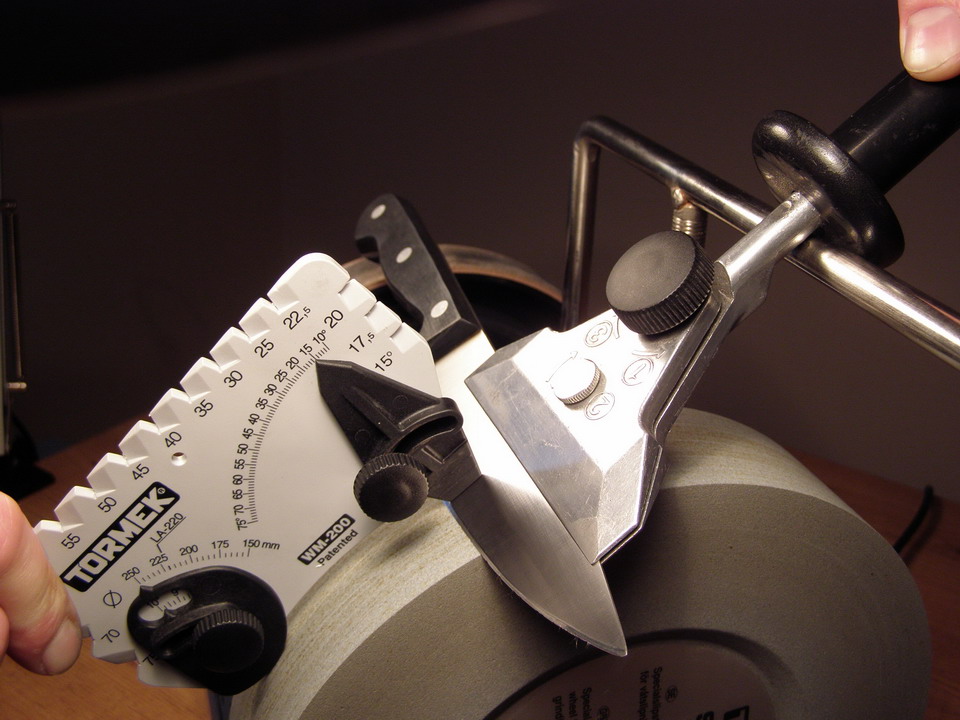
Choosing the angle of sharpening a kitchen knife
electric sharpener
Electrically driven devices - a grinder, emery, grinding wheels - save time and effort and restore sharpness to knives in a relatively short time. But if you do not have the skill to work with such devices, you should not use them to sharpen kitchen utensils. These are complex devices that the master must work with.
Another thing is specialized electric sharpeners designed for kitchen utensils. How to sharpen a knife on such an electric sharpener, even a beginner will figure it out.
There are many varieties of electric sharpeners, from compact home to professional, allowing you to achieve the highest sharpness of the blade. This device is useful for those who have a lot of different knives in the kitchen. Using it is easy: just turn on the sharpener, insert the blade into the slot and swipe back and forth a few times. In addition to ease of use, electric sharpeners have another plus: they provide excellent cutting edge quality. The only downside is that you will not be able to sharpen the tool “under your hand” (that is, with the sharpness of the blade and the width of the leads you need): electric sharpeners are set to a universal form of sharpening.
An electric sharpener is a great gift for a good housewife: with it, she will always be able to keep her knives in great shape without resorting to outside help.
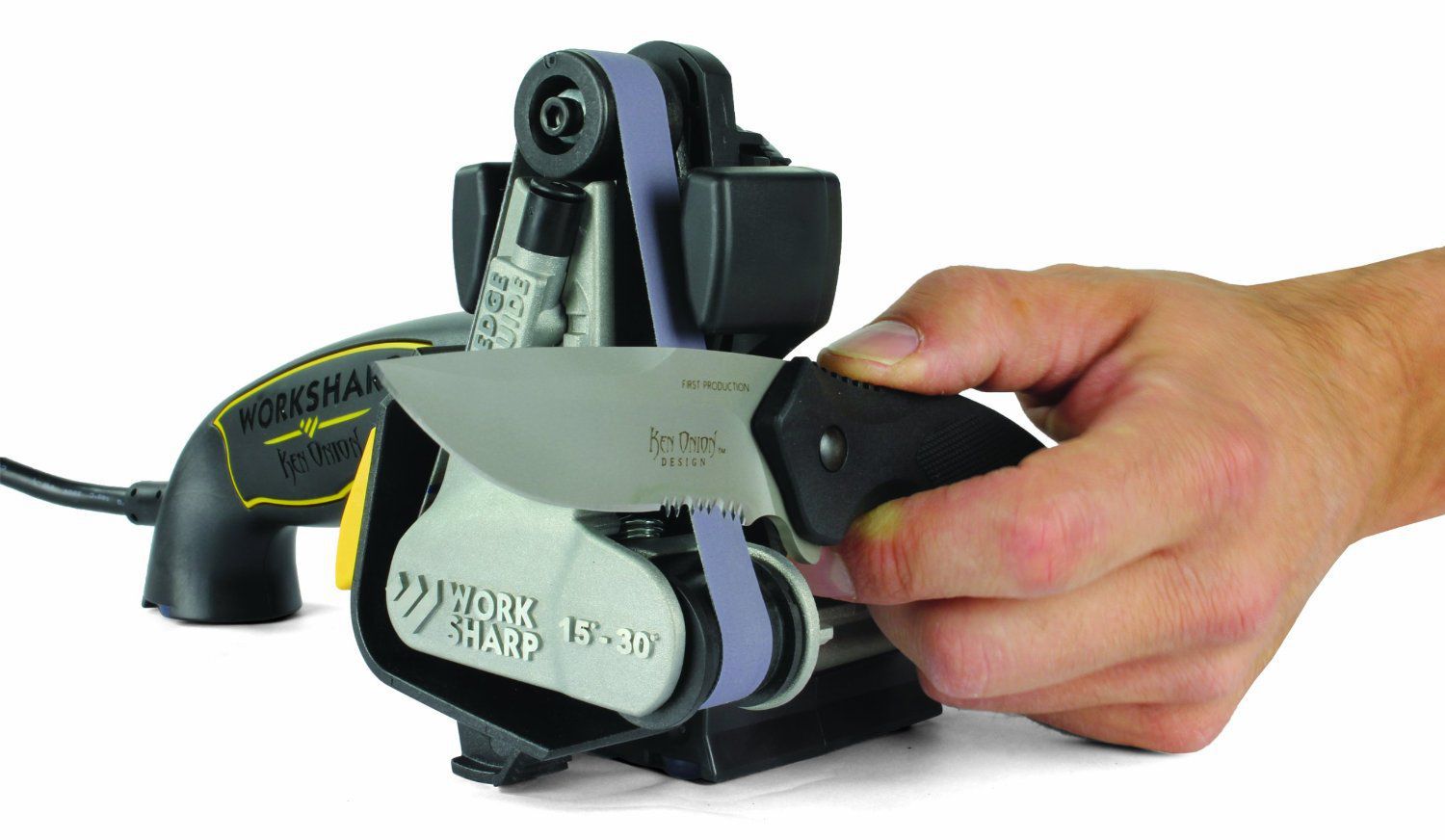
Musat
This is the name of a tool that looks like a round file. It can be sold separately or included in a kitchen set. Musat helps not to sharpen, but rather to straighten the blade of the tool that is often used. If the knife has completely lost its sharpness, it is better to use a whetstone or electric sharpener.
How to sharpen knives with musat? One technique: rest the end of the “file” on the table and run the blade over it several times with medium pressure. Remember the optimal sharpening angle - 20–25 ° to the plane of the tool. Another technique: hold the musat on its weight and make vigorous "attacks" with the blade on its shaft, at an angle of about 45 °. How to sharpen knives with musat is best demonstrated by the video.
whetstone
A bar, or a grindstone, is an almost eternal thing. It can last for years, being passed down from generation to generation. Surely, in your kitchen cabinet there is a bar left over from your grandfather. Sharpening knives with a whetstone is a versatile and most convenient way. It can be used in the city kitchen, on a hike and in country house; the bar is very compact. Knowing how to properly sharpen a knife with a bar is not something secret. It's pretty easy, although it does take some getting used to and some experience.
Place the block on the table horizontally (i.e., the long side should go from left to right). Correctly sharpening a knife with a bar will not work if the table is unstable, and the “stone” itself has an irregular geometry and does not lie flat.
Take the knife by the handle, and place the fingers of your other hand on the blade.
Slowly and evenly drive the knife along the bar in a semicircular path, observing the angle of inclination (20–25 °). Each side of the blade should take 5-7 minutes.
The secrets of the master: sharpening will turn out smoother if a few drops of oil are dropped on the bar, and the blade is moistened with cold water.
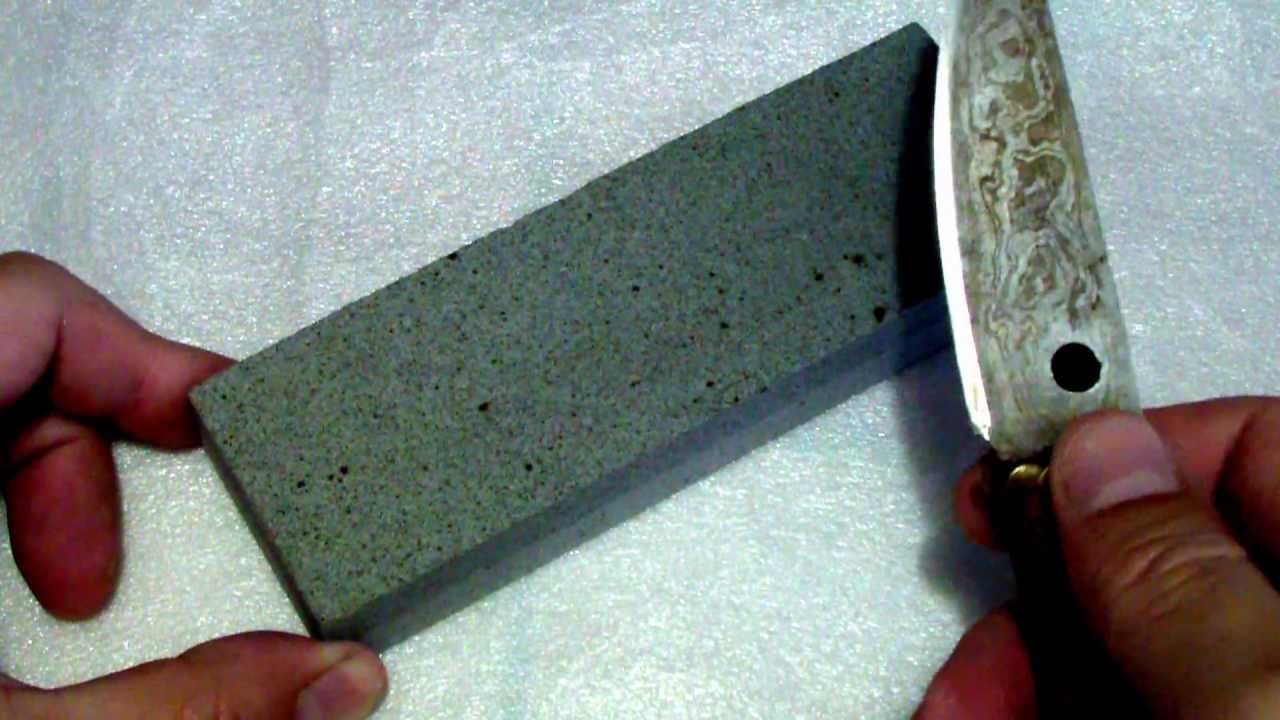
Bars are different shapes and with different fraction of grain. The larger the grain, the more metal it takes off the blade. Sharpening is fast, but rougher. A good whetstone can cost a lot, and a real master for a first-class sharpening may need several stones - at least with a large grain (for basic sharpening) and with a fine one (for fine-tuning). good decision becomes a universal bar, different faces of which have different grain sizes.
Imported bars have a special marking that allows you to determine the grain size (it is measured in different units, but general principle one: the larger the number in the marking, the finer the grain). Russian bars do not have markings. You will have to pick them up by eye. As for quality, here the bars of different producing countries are approximately equal. Price can be a guideline: the more expensive, the better material. Diamond-coated bars are most valued.
To make the blade perfect, after the main sharpening, make several movements on a fine-grained bar (or on a fine sandpaper). More clearly on how to sharpen a knife with a bar, the video will tell.
Mechanical sharpener
A manual disk sharpener is a simple device for quickly sharpening knives. Of course, the block helps to achieve a smoother and sharper blade edge, but for a kitchen knife, the sharpness that a sharpener can usually give is usually enough.
Advantages of a mechanical sharpener: decent sharpening quality with low price; ease of use. Fix the sharpener on the table with one hand; in another, take a knife and several times with force draw it into the slot.
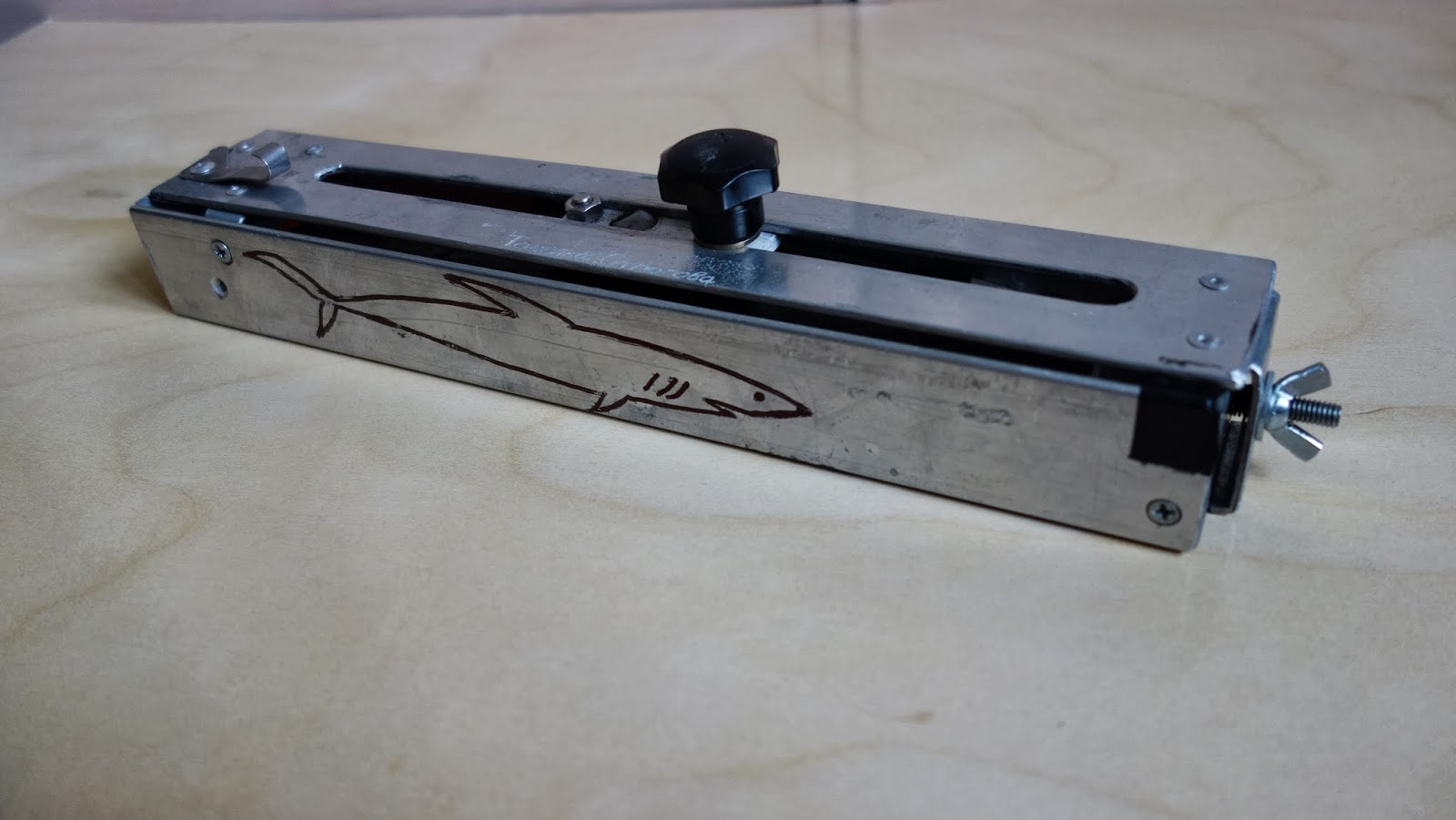
Manual knife sharpener
Among all the varieties of this simple device, the best is a diamond sharpener for knives, that is, with diamond coating on the disks. It helps to achieve the best sharpening with a minimum of effort. By the way, musat, like grindstones, can also be coated with synthetic diamond. Such sharpening tools should be preferred.
Emery for sharpening knives
Electrical and mechanical sharpeners, musats and bars are simple tools for sharpening tools that even beginners can use. But if you are an experienced craftsman who knows how to handle tools, then in a few seconds you can sharpen a knife on ordinary emery.
For sharpening knives, it is better to use a fine-grained wheel. Turn on the device at low speed and run the blade along the side of the circle several times. Don't forget about the sharpening angle, which is still 20°. Here the angle is especially important, because if you do not observe it, you will spoil the approach of the knife.
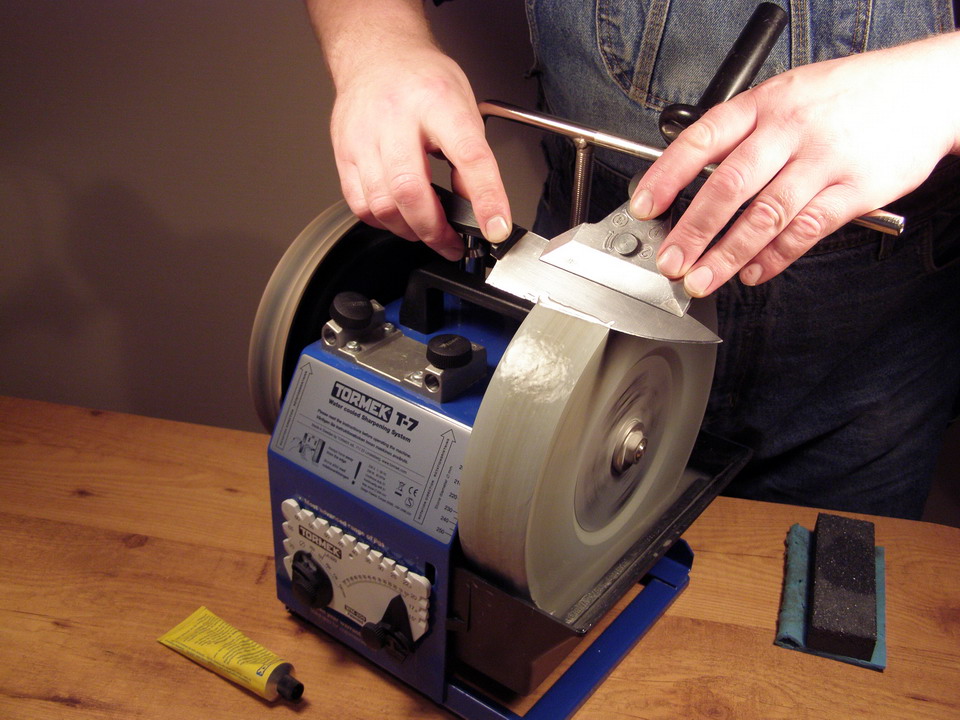
Sharpening on emery is usually quite rough and needs to be fine-tuned. Use a fine-grained whetstone or fine sandpaper for this.
If there are no tools at hand
There are situations when there are no tools at hand at all, and sharpening a blade is a matter of life and death. For example, you found yourself without a sharp knife on a campaign or found yourself visiting a charming girl whom you want to demonstrate your masculinity.
Here are some tips on how to "refresh" a knife blade with the simplest tools at hand. This is an unreasonable sharpening, but rather a fine-tuning - but the tool after them will definitely cut better.
- Any stone. As you know, you can sharpen a knife with any stone, including brick or cement block. The procedure here is the same as with grindstone: Move the blade in circles along its surface or edge, maintaining the correct angle.
- Ceramic plate. Ceramics slightly harder than metal, so the back of the pottery is also suitable for sharpening kitchen tools. This method helps to sharpen the blade no worse than a bar - although such a procedure will take an order of magnitude more time.
- Sandpaper - "skin". It will not work well to sharpen a dull blade with the help of a skin, but it will help to “bring” a slightly dull blade.
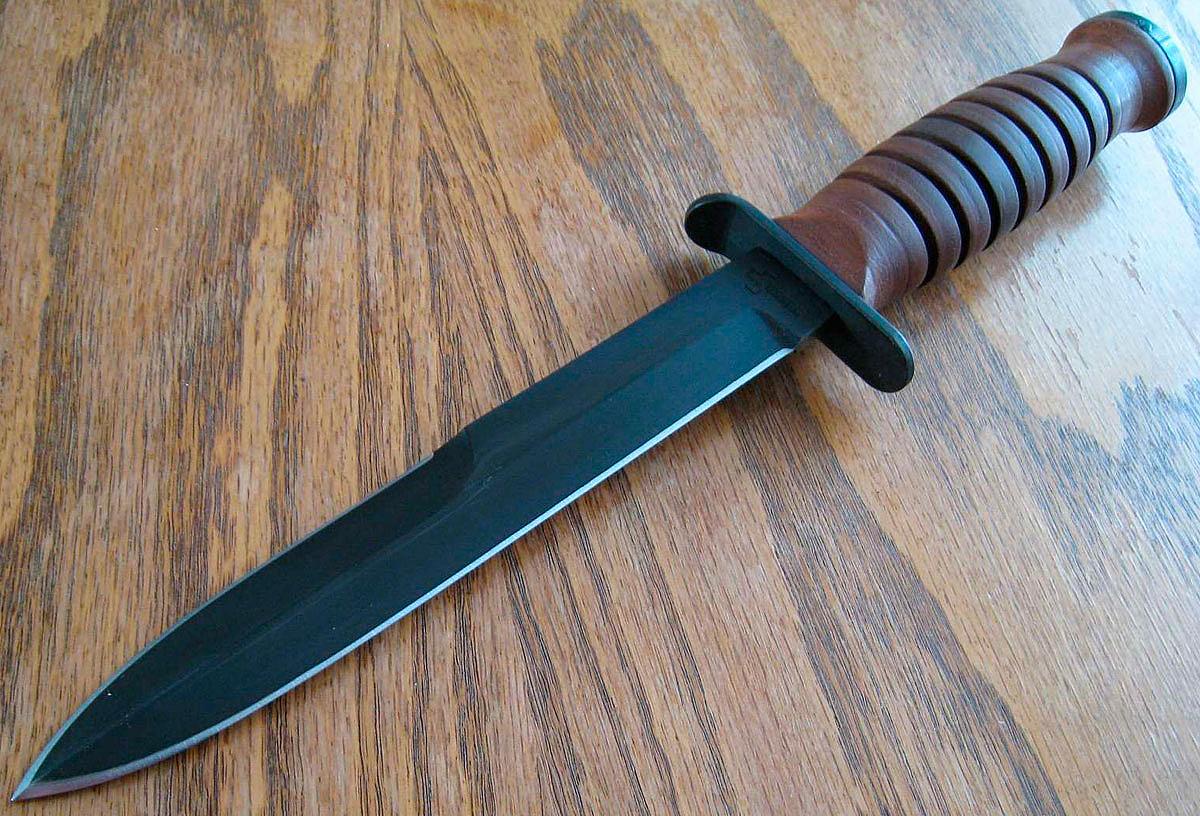
Checking the result
Anyway, our knife is sharpened. How to check whether we have reached the goal and whether his blade has become better?
Sharpening is considered ideal, in which the blade cuts the hair from the hand or cuts the paper in a perfectly even line. But for kitchen needs, a weaker sharpening is also quite suitable. Test your knife on any vegetable or fruit: if the blade easily cuts through the skin and can cut the flesh into even cubes, then congratulations - you did it!
There are quite a few opportunities and ways to sharpen knives, although this is increasingly becoming a problem, well, as for women, it is clear that for women this process is more complicated, but mostly in the process itself than in laboriousness. In this article, I would like to emphasize the simplicity of the issue and give small recommendations on how to sharpen a knife on sandpaper.
Electric emery is a necessary thing in the household, and if for those who have not yet bought emery, the question arises, why is it so good - we answer that any knife, ax blade, garden shears and any other cutting and piercing metal object can be sharpened within in a matter of seconds - it is enough to turn on the emery and, with reciprocating movements of the hands, draw the blade at the required angle touching the intersection of the end face and the cylinder of the abrasive wheel.
Produced for home use, electric emery, as a rule, there are two abrasive wheels - one coarse grit, intended mainly for rough removal of metal, used to give the correct shape, and the second - fine grit, used for finishing purposes, giving the surface a more accurate look .
Small and medium knives are sharpened on an abrasive wheel with a fine grain. It is more correct to sharpen the knife along the side surface of the abrasive wheel, while the sharpening angle can be different, depending on the use of the knife (from 20 to 40 degrees). However, it is rather difficult to determine the degree, so it is better to be guided by the width of the supplies (width of the part to be ground). If you correctly maintain the angle when moving the knife, then the supply will be the same. And if the sharpening is not correct and the angle is not sustained, it will be of different widths. With too sharp a degree of inclination, the width of the approach can be up to 4-5 mm, while for a knife they should be about 2-3 mm.
With proper sharpening, it is necessary to achieve a smooth, accurate approach, with the same width and complete symmetry on both sides of the blade. After sharpening on emery, it is advisable to correct the knife and remove burrs.
RVT
Sharpening of knives, which can be carried out different ways for some reason became a problem. It is clear that for women this process is more complicated, but mainly in the process itself than in labor intensity.
In the presence of any emery, the issue of sharpening is not difficult. For those who have not yet bought emery, the question arises, why is emery so good? The answer to this question is simply any knife, ax blade, garden shears and any other cutting and piercing metal object can be sharpened in a matter of seconds - just turn on the emery and with reciprocating hand movements, draw the blade at the required angle touching the intersection of the end face and the abrasive cylinder circle.
Electric emery, as a rule, has two abrasive wheels - one coarse grit, designed mainly for rough removal of metal, used to give the correct shape, and the second - fine grit, used for finishing purposes, giving the surface a more accurate look.
Sharpening of knives is carried out on an abrasive wheel with a fine grain. For smoother sharpening, it is better to sharpen the knife with the side surface of the abrasive wheel. The sharpening angle can be different, depending on the use of the knife from 20 to 40 degrees. But it is better to be guided by the width of the supplies (width of the part to be ground). So with improper sharpening and an unbalanced angle, it will not be the same and rather wide up to 4-5 mm, while for a knife they should be about 2-3 mm.
When sharpening, it is necessary to achieve a smooth, accurate approach, with the same width and complete symmetry on both sides of the blade. After sharpening on emery, it is advisable to correct the knife.
RVT











Chicken in kefir - recipes for marinated, stewed and baked poultry for every taste!
Simple Chicken Recipe in English (Fried) Recipes in English with translation
Chicken hearts with potatoes: cooking recipes How to cook delicious chicken hearts with potatoes
Recipes for dough and fillings for jellied pies with mushrooms
Stuffed eggplant with chicken and mushrooms baked in the oven with cheese crust Cooking eggplant stuffed with chicken